#heathenism
Explore tagged Tumblr posts
Text
Casual ways to connect with your deities
-Pray to them or just just talk with them and tell them about your day
-Light a candle and say your thanks
-Offer your meal/snack to them or bake/cook with them or for them
-Watch a movie in their honor
-Offer your morning drink to them or make a cup for them
-Assign them a plant and take care of it as a devotion to them
-Listen to music that reminds you of them
-Say good morning/good night
-Thank them for the things you see that you consider beautiful
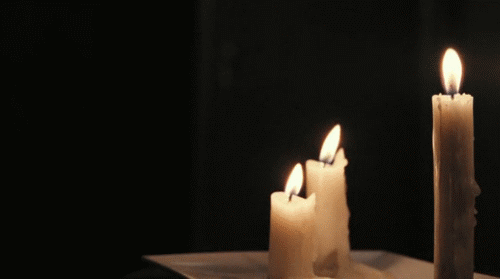
#paganism#pagan#polytheism#hellenic polytheism#hellenic pagan#hellenic paganism#hellenism#kemetic#kemeticism#heathenry#heathenism#norse paganism#deity devotion#deities#deity#deity work
7K notes
·
View notes
Text
| Just a reminder to people : You do not need an altar for deity work. You do not need to spend a lot of money on offerings or rituals. You do not need to hold yourself to the standard of other people's practice. This is your journey and your relationship with the gods. They understand what you have and they understand whats available or any circumstance you are in. I am a strong believer that, if an offering or devotional work is with good intentions and done so from the heart, it's more than good enough and your deities will be more than happy and accepting. Even if it's not a historical offering or even if it's something simple like saying good morning in your mind, they take notice and they love you for you. Having an altar or performing rituals is great, I have an altar myself! However, it's not a necessity, especially if you cannot make one/have one.
#deity work#deity worship#kemetic#kemetism#paganism#hellenic polytheism#helpol#hellenic pagan#norse paganism#heathenism#witchy#witchcraft#witchblr#netjeru#theoi
457 notes
·
View notes
Text
Fellow pagans. Remember that the pagan experience is not purely an ex Christian experience. That experience is worth talking about, but please don't talk about the pagan experience as if leaving Christianity is universal to being neopagan.
Ex atheist pagans deserve to have their experiences acknowledged by the community.
Ex Muslim pagans deserve to have their experiences acknowledged by the community.
Non practicing Jewish pagans deserve to have their experiences acknowledged by the community.
Pagans who have been pagan for most or all of their life deserve to have their experiences acknowledged by the community.
#196#paganism#paganblr#pagan community#pagan culture#pagan#hellenic pagan#hellenic polytheism#norse paganism#norse polytheism#norse heathen#heathenism#heathenry#celtic paganism#celtic polytheism#ex christian#ex muslim#ex atheist#atheism#jewish#non practicing jew
465 notes
·
View notes
Text
Remember
You don’t need to use divination to be a pagan or polytheist. You don’t need to be able to feel your Gods. If you can’t do divination or can’t feel your gods that’s alright - that’s normal!
#hellenic polytheism#helpol#hellenic paganism#pagan#paganblr#kemetic#norse paganism#heathenism#heathenry#egyptian paganism
151 notes
·
View notes
Text
My most controversial take is that I think if youre going to be any kind of culturally based polytheist, you should a) learn the language and b) learn to do scholarly research.
I wont use the word "must", and call me a gatekeeper all you like, but there is so much misinformation out there that if you care about your practice being authentic/culturally sensitive AT ALL you need to learn how to sift through the centuries of romanticism and neopagan-speculation-sold-as-fact (looking at you, Wiccans).
Not saying your practice must be reconstructionist in nature, but if you can't tell what is supported by the data, what is conjecture, and what is outright fabrication, you are doing the material, your practice, and yourself a disservice.
#gaelpol#gaelic paganism#gaelic polytheism#celtic polytheism#heathenism#heathenry#norse paganism#norse polytheism#hellenic polythiest#hellenic pagan#hellenic polytheism#paganachd#irish paganism#celtic paganism
369 notes
·
View notes
Text
i find it fascinating how my perception of the gods have changed once i met them. both in looks and personality.
Freyja, related to beauty, love and lust, i believed would look young and very feminine. Yet, when presented with her, she was a gorgeous, mature woman with lines at her eyes and a towering figure. The realization that a goddess I acknowledge as being so gorgeous had wrinkles and strong facial features made me reconsider my own perceived “flaws” and standards of beauty. She was beautiful in her strength and wisdom and yet also in her divinity and confidence. I had forgotten a woman of extreme beauty was also a goddess of war. And in both being true, I found her to be the most powerful woman I know.
Seeing Hades, I believed he would be fearsome and cold. Yet, when I looked into his eyes, there was warmth. He had an appearance of a man in his 40s with long hair, the color of the night, and he had no resentment or even disdain. Only softness. I didn’t fear him nor did he try to have me do so. He was safe as he led me through the courtyard where we met. Where I thought he would be an imposing and cold-hearted figure, I found someone with such patience like a father-figure would have.
Apollo, whom I thought would be bubbly and funny from how I’ve seen others described him was indescribably elegant. He carried himself well. He was kind and patient. Where I thought I would find youthful naivety, I found charm and elegance. And he only asked to help me in my healing. Even when I thought I did not need him, he waited patiently until I could hear him properly. And no matter how long it took, he was still welcoming with a smile.
I truly believe everyone should have the opportunity of meeting their deities and finding how they appear to them. What they show themselves as is what you may need. I find it fascinating to see how others see them :) They love us very much.
#deity work#deity worship#apollo deity#apollo worship#hades deity#hades worship#freya deity#freyja#freyja deity#freyja worship#hellenic polytheism#hellenic pagan#hellenism#hellenic deities#norse paganism#norse heathen#heathenry#heathenism#paganism#pagan witch
753 notes
·
View notes
Text
I need more pagan blogs to follow that are chill with me (a queer eclectic Christopagan) following them! Any pagans generally, but especially if you're eclectic/syncrectic, Heathen, or Hellenic, and especially especially if you're Ozarker or Urglaawer (howdy kin! :D) If you're pagan and friendly, give this a like or reblog so I can check you out! Peace and blessings upon all of you 🥰
#pagan#hellenic paganism#hellenic polytheism#hellenic pagan#hellenism#hellenic deities#hellenic worship#hellenic gods#heathenry#heathenism#inclusive heathen#inclusive heathenry#germanic polytheism#germanic paganism#norse polytheism#norse paganism#norse pagan#norse gods#urglaawe#urglaawer#ozark pagan#ozark paganism#christopagan#christian polytheism#unitarian universalism#unitarian universalist#omnist#eclectic pagan#eclectic wicca#wiccan
159 notes
·
View notes
Text
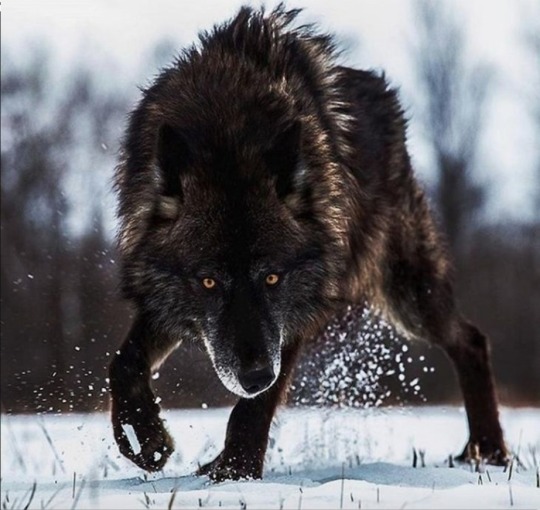
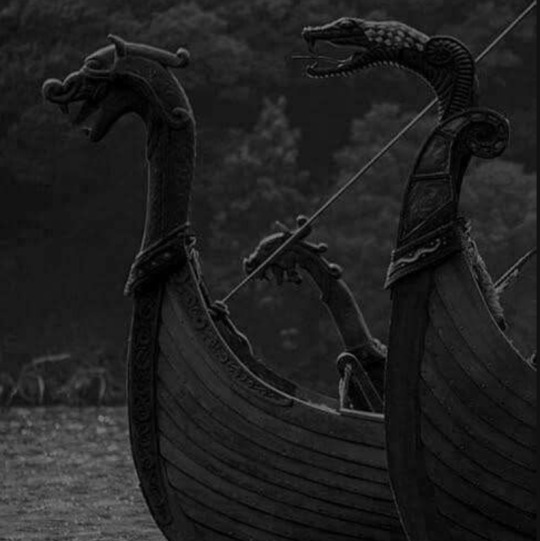
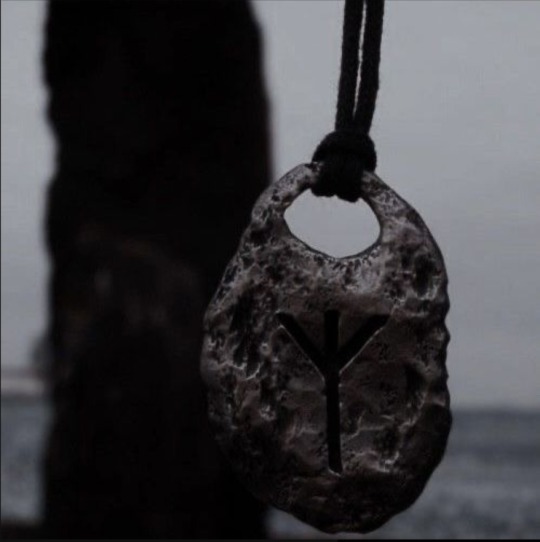
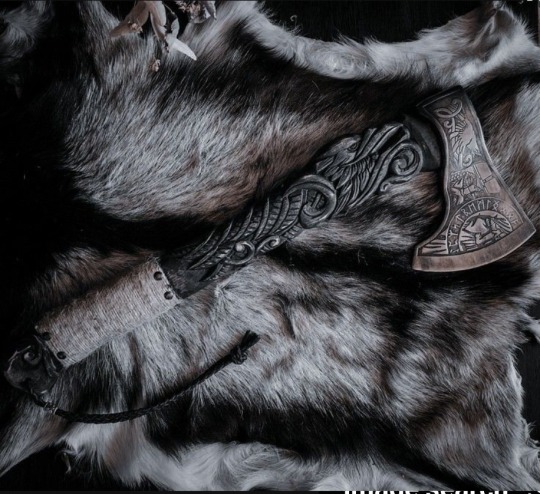
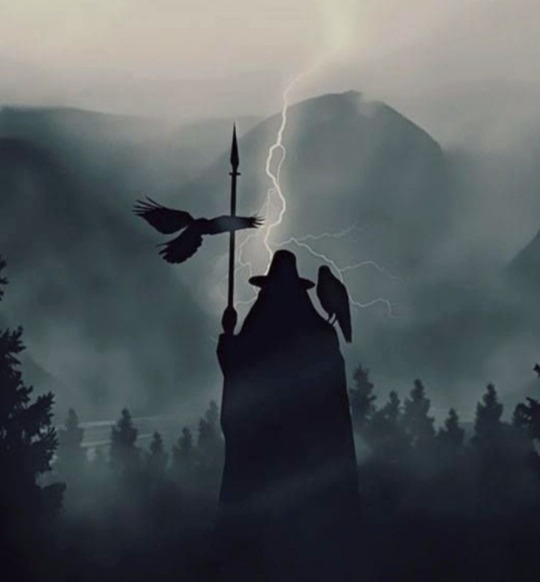
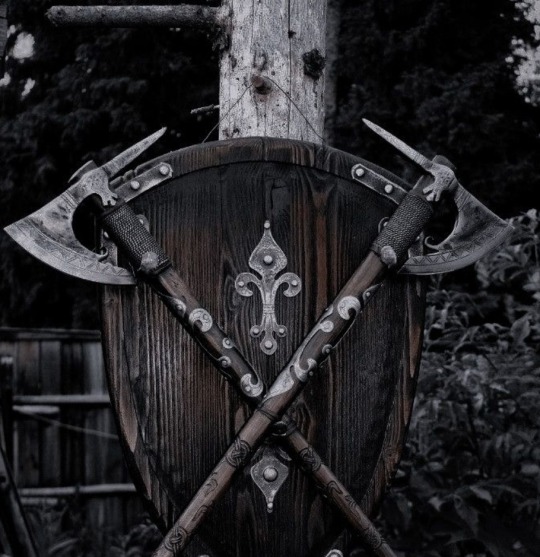
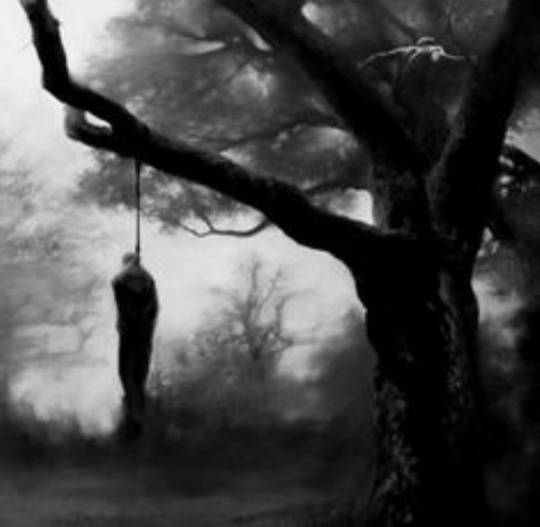
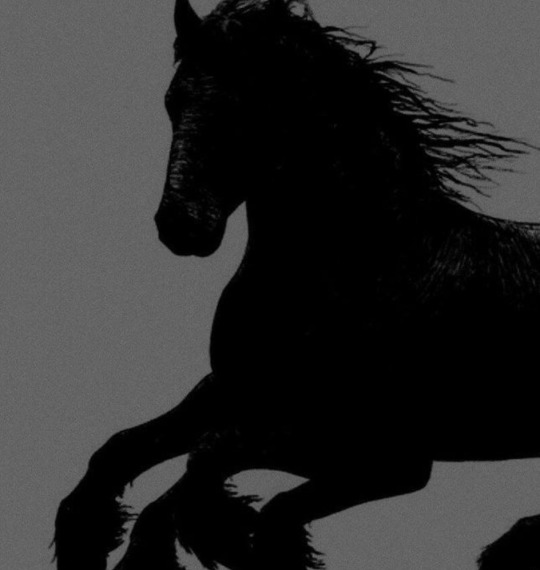
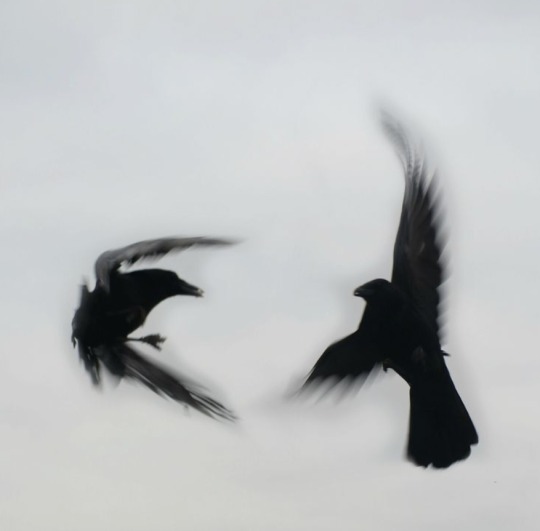
Óðinn the Allfather: ruler of Valhalla and God of wisdom, magic, runes, war, prophesy, victory, poetry, and death.
#Óðinn#Odin#pagan#deities#polytheism#polytheist#deity#paganism#heathenry#heathenism#norse pantheon#norse pagan#norse#norse mythology#norse paganism#norse gods#norse heathen#odinn#the allfather#the wanderer#havamal#deity moodboard#moodboard#devotional moodboard
256 notes
·
View notes
Text
Lady Sekhmet, Lord Maahes, I pray to you to end this slaughter of Palestine's children, to let them safely pass into Egypt
Lord Zeus, Lord Tyr, I pray to you to bring justice to those killed and who's homes were stripped from them
Lord Ares, Lord Thor, I pray to you to give strength to those protesting bravely against this corrupt government funding this genocide
Lord Njordr, Lady Hathor, Lady Aphrodite, Lady Demeter, I pray to you to bring abundance and love and comfort to Palestine's children, for mercy upon the land that has been destroyed, for life to be salvaged and to flourish
I pray to all the gods for this genocide to end and for the corrupt system that feeds this genocide gets the justice they deserve.
From the river to the sea
Free Palestine
Edit: don't tag this "two state solution".
#free palestine 🇵🇸#gaza#free gaza#palestine#pagans for palestine#hellenic polytheism#paganism#hellenic pagan#helpol#paganblr#hellenic paganism#hellenism#kemeticism#kemetic#kemetic paganism#kemetic polytheism#kemetism#heathenry#norse heathen#heathenism#norse polytheism#norse paganism#norse pagan#norse gods#dua sekhmet#Dua Maahes#zeus deity#tyr deity#njordr#njord
299 notes
·
View notes
Text
Did Christianity Steal From Paganism? Yes... No... It's Complicated. Part 2: Vikings
Tis the season so I figured I'd talk about the topic that's been the subject of debate for a long time, most recently with the 2024 Olympics. I will be discussing the visual aspect of these religions, not the theological aspects.
Short answer: Yes
Long answer: No
Let's get into it: The Viking era is from 800-1050 AD and can be divided into seven parts based off the style of visual art that was popular. The first style is called the Oseberg style (775-800 AD) and would be the basis of all the Viking styles of art after it. It was made of three forms that were derived from Pagan pre-Viking art: ribbon animals, gripping beasts, and ambiguous forms. You can see it on the bow of the ship below; the ship dates to the 9th century and was found in a burial mound in Tønsberg, Norway. Remember these forms because they're going to be important later.
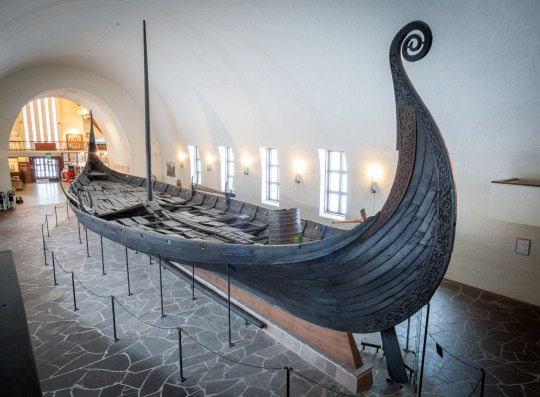
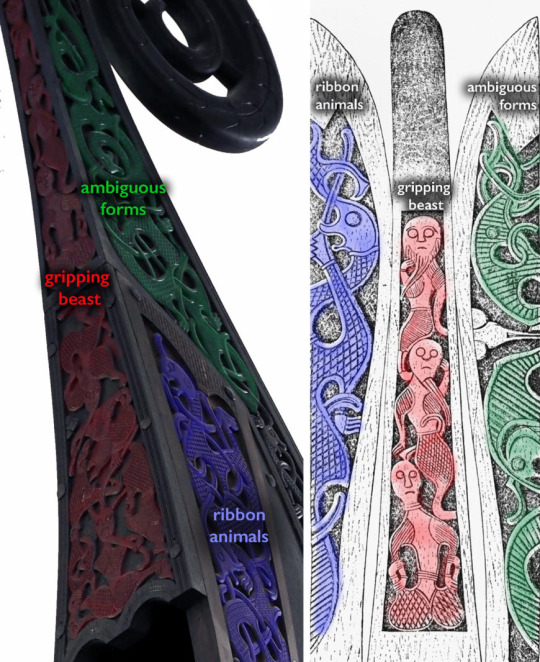
The Vikings started coming into contact with Christian Anglo Saxon (modern day English) missionaries in the 700-800s, but they had little effect. The missionaries were well received by the kings but when their Pagan chieftains threatened to rescind their support, the missionaries were sent away. Another example of that is in 878 AD, the Christian king of the Anglo Saxons, Alfred the Great of Wessex, and the Pagan king of the Vikings, Guthrum the Old, were at war. King Alfred ended up winning and as part of the peace treaty, Guthrum had to get baptized into Christianity. He did so but maintained his Pagan worship and did not implement Christianity.
Besides the kings, common people had also started to slowly assimilate to Christianity. Christians had a rule that they couldn't trade with Pagans so Pagan Vikings began primsigning. Primsigning is an old Norse word meaning "to make the sign of the cross," the way to show you followed Christian beliefs before converting all the way through baptism. Even though they weren't being baptized and were still practicing Paganism, primsigning was enough for Christians to feel comfortable trading with them and brought the Vikings more into the world of Christianity.
An interesting example of this is in Kopparsvik, Sweden, where a large number of Viking individuals were buried in a prone position from 900-1050 AD. This is completely different from traditional Pagan Viking burials: there were no grave goods, no animal sacrifices, no mighty ships. Typically, a prone position is a sign of showing humility towards God and all the figures had notches carved into their teeth (below). Historians theorize that they used the notches to secretly signal to Christian merchants that they were also Christian to get discounts while not being alienated from their Pagan communities.
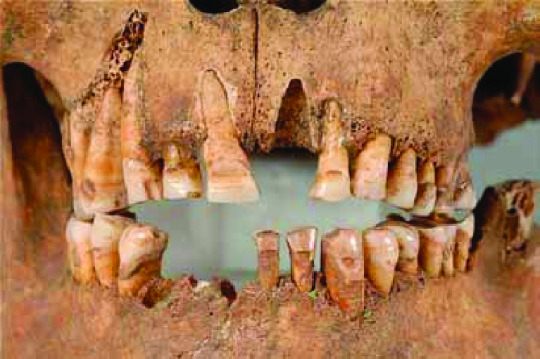

The coin below is from ~921 AD. It's a Viking coin from York, England and wonderfully shows the mixing of Pagan and Christian iconography. Coins like this typically had the name of the Viking king engraved on them but this one has "St. Peter." However, it also depicts the hammer of Thor on both the head (left) and reverse (right). It really demonstrates the visual mixing of religions.
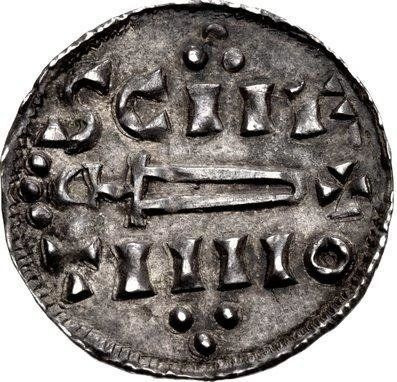
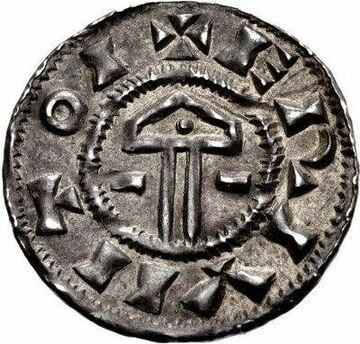
Sometime between 940-1000 AD, the cross below was made. It was found in St Andrew's Church, Andreas, Isle of Man (between England and Ireland), and is another great example of the combination of Pagan and Christian art. On one side (left) it depicts Odin with one of his ravens fighting the wolf Fenrir at Ragnarök. The other side (right) depicts Christ triumphing over Satan. Both of these are stories of good vs evil and depict a god triumphing at the end of days. It would have drawn attention to the theological similarities between Christianity and Norse Paganism, making it easier for people to conflate the differing theologies.
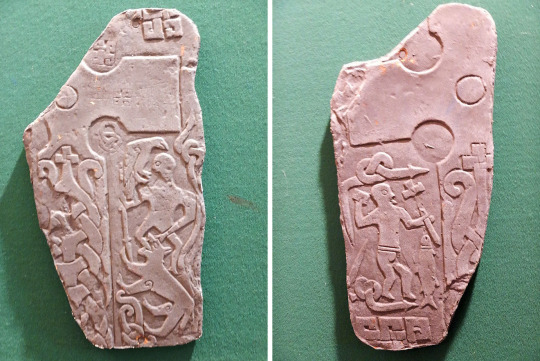
Remember the Oseberg style from before? We're going to revisit it. By the 900s, Viking art was being done in the Mamman style; the ribbon animals and gripping beasts had combined into an icon called the Great Beast. The Great Beast was a symbol of power and strength, frequently put on longships and other Pagan items. In 986 AD, Viking King Bluetooth, a recent convert to Christianity, had the jelling stone below erected in honor of his deceased parents. On one side, he included a Great Beast; this was to show the strength and nobility of his parents and the nation they ruled. On the other side, he put an image of Christ Triumphant. This makes sense for a cenotaph as the promise of a resurrection is a comfort in the face of death. But the combination of a Pagan symbol of strength and an image of Christ is very interesting; it's doing more than pointing out the similarities between the two religions, it's uniting both Pagan and Christian subjects under his rule and proudly displaying the two different sources of the Viking's strength.
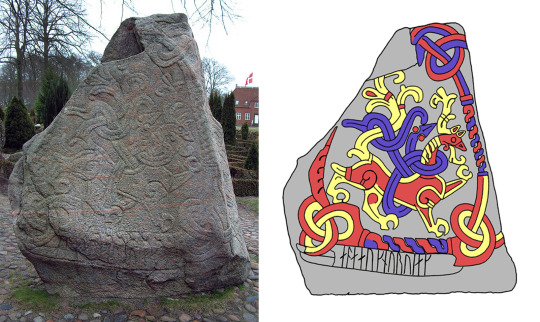
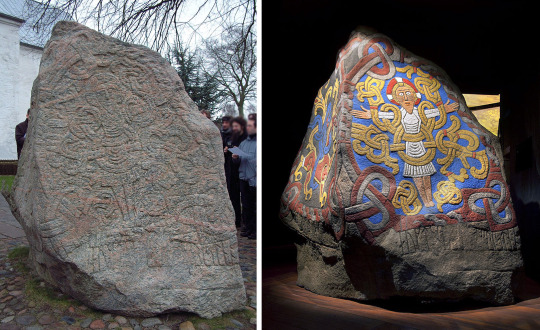
I can't end this without also talking about architecture. The last Viking art style is called the Urnes style and it's primarily because of the church below. It was built in 1132 AD in Urnes, Norway and is a stave church, meaning the whole thing was built without any nails!! The entire thing is self-supporting wood made using the post and lintel system. It's a Chrisitan church but has Pagan iconography on the sides: the last version of the Great Beast (right) and Pagan runes. It's fascinating how a Christian place of worship is decorated and protected by Pagan icons, once again showing the combination of visual cultures and methods of thought.
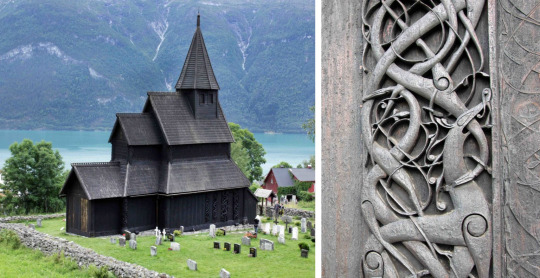
So, the answer everyone is looking for is NO.
The Christians didn't steal anything from the Pagans, they made an association. They produced art in the style that was popular and followed the artistic trends of the time. Christian and Pagan imagery was produced in the same medium and combined until Paganism was phased out over hundreds of years. They saw similar gods and iconography and combined them to make a message that was understandable to all audiences.
Happy Yule! Happy Winter Solstice!
Further reading:
Smarthistory – Art of the Viking Age
BBC - History - Ancient History in depth: Viking Religion
The Vikings and Christianity | History of Christian Vikings – Sons of Vikings
Treaty of Wedmore - Wikipedia
Manx runestones - Wikipedia
Prone Burials and Modified Teeth at the Viking Age Cemetery of Kopparsvik - Historische Beratung Dr. Matthias Toplak
Ancient Viking Art - Medievalists.net
Gamla Uppsala - Wikipedia
#i tried to include both academic and general further readings#this is very simplified bc i'm trying to give a general overview#yule#artist talk#ancient art#pagan witch#paganism#pagan#paganblr#christianity#norse paganism#celtic paganism#norse mythology#celtic mythology#norse art#celtic art#scandinavian folklore#scandinavian mythology#thor#odin#jesus christ#norse heathen#heathenism#winter solstice
67 notes
·
View notes
Text
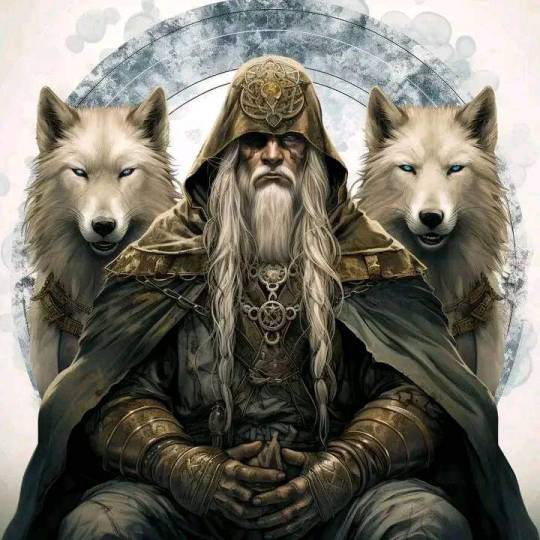
#heathen#heathenism#norse mythology#asatru#polytheism#norse pantheon#norse heathen#norse paganism#norse gods#norse#odin#viking god#viking#vikings#wolves
163 notes
·
View notes
Text


I was inspired to design a pro-diversity and inclusivity symbol that I call the Othalwynn, it is a bindrune of Othala and Wunjo with features referencing the progressive pride flag. Wunjo is here representing friendship, kindness, sanctuary, tolerance. Here Othala is representing how we all are part of the same family, we are all branches of the same tree. I carry this further in the second symbol here which is a spin-off, the Othalwynn Yggdrasil, symbolizing the connection between all our different worlds and how we flourish and grow the strongest when diversity is nurtured. We are all branches of the same tree. Please feel free to use it!
#norse paganism#heathenism#norse runes#bindrunes#queer#lgbtqia#lgbtq#mine#pagan#witchcraft#sigil#diversity#blacklivesmatter#inclusive#othalwynn#yggdrasil
112 notes
·
View notes
Text
When I was praying to Hel last night she told me that sometimes you're weak in a way that's solved by practice and training, but sometimes you're weak in a way that's solved by rest and healing. I feel like I should share that with you (she said it was ok to post this).
#196#norse paganism#norse gods#norse heathen#norse mythology#heathenry#heathenism#hel goddess#hel#norse hel#paganism#paganblr#pagan#mental health#healing#trauma
113 notes
·
View notes
Text
You don’t need to wait for a God to “call to you” by the way. You don’t need ask permission to worship. You can just do it. Seriously, you can find a god and start worshipping.
I see a lot of people new to Polytheism or Paganism asking how to begin, how to know if a God is reaching out. But the answer is you don’t have to know. You don’t even need a God to reach out, you can just decide to worship. Go ham! Research the Gods and worship to your hearts content.
#hellenic polytheism#helpol#hellenic paganism#pagan#paganblr#kemetic#norse paganism#heathenism#heathenry#kemeticism
119 notes
·
View notes
Text

Bronze Age lady
94 notes
·
View notes